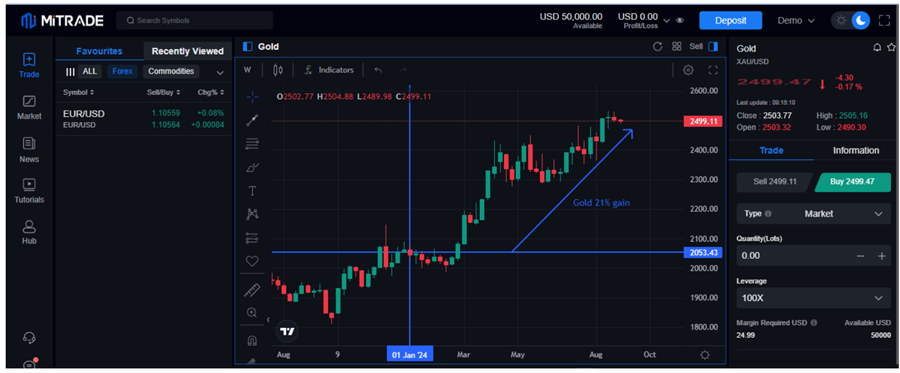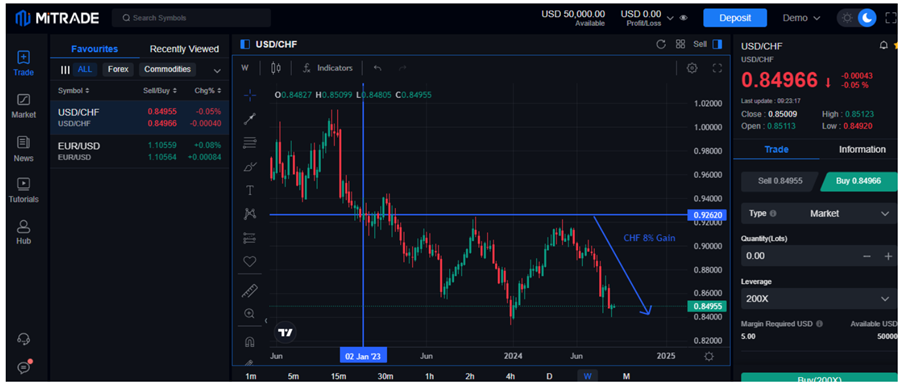
Investing in the financial markets has to be one of the most rewarding adventures. However, things can turn sour in the blink of an eye. Given the ups and downs always in play, is it possible to make money even when the market is in a downturn or crashing? In come Safe Haven assets.
1. What are Safe Haven Assets?
Simply put, safe haven assets are those that tend to outperform other securities during market downturns. True to their name, they are asset classes that investors turn to because of their ability to appreciate in value even when the overall market is crashing.
Importance in an Investment Strategy
They are some of the most important asset classes to include in an investment portfolio as one of the ways of achieving a high level of diversification. Given their negative correlation to the general market, they are able to shield a portfolio from the effects of extreme volatility.
Given their ability to maintain value, they stand out as symbols of stability and financial security, doubling up as a store of wealth. Some act as guardians against skyrocketing inflation and are often used as a hedge. Gold is a perfect example of an asset often used to offset the effects of rising inflation.
Characteristics of Safe Haven Assets
The following are some unique features that define safe haven assets:
Liquidity: Major safe haven assets are known for their high liquidity, allowing people to easily convert them into cash. The conversion makes it easy to buy and sell in response to the various economic conditions.
Functionality: Besides serving as investment assets, they also come with other use cases that ensure their long-term demand. For instance, the electronics industry and jewelry use silver and gold, the most sought-after haven assets, extensively.
Limited Supply: The assets accrue value from their limited supply; given their limited supply amid heightened demand, such asset class tends to increase in value over time, acting as a reliable store of value.
Certainty of Demand: The fact that the asset class cannot be replaced or become outdated makes them highly acceptable across the globe.
2. Common Types of Safe-Haven Assets
If any financial instruments come to mind after scanning the characteristics of safe-haven assets, let’s list all common types along with some highlighted features:
Asset Type | Stability | Liquidity | Historical Performance | Yield Potential | Risk Factors |
Gold | High | Moderate | Strong during crises | Low | Volatility, storage costs |
Government Bonds | High | Low | Strong during crises | Low | Tax considerations Dropping interest rates |
Currencies | Low | High | Moderate during Crisis | High | Heightened Volatility Weak economic conditions |
Defensive Stocks | Low | Moderate | Moderate During Crisis | High | Company’s Deteriorating earnings results |
Gold
Throughout history, precious metal has risen sharply during major financial downturns. This was particularly true during the 2008 financial crisis when gold investors saw a 20% return on their investment.
High liquidity makes the yellow metal a straightforward investment for people looking to buy or sell and profit from price differences. Due to its tangible nature, gold, unlike other assets, remains unaffected by economic conditions such as currencies, interest rates, and inflation, making it a crucial investment for safety.
Over the past four years, gold has enjoyed a compound annual growth rate of 5.35%. Amid the heightened geopolitical tensions in 2023 in the Middle East, it generated an annual return of 13.80%.

Image Source: Mitrade
Likewise, gold is up by 21% year to date, outperforming the S&P 500, which is up by about 17%. Its outperformance in 2024 concerns growing concerns about the global economy plunging into recession amid the high interest rate environment. Uncertainty over the U.S. election and increasing tensions in the Middle East and Europe have forced investors to turn their attention to the safe haven.
Government Bonds
They are financial instruments guaranteed by the government's full faith and credit, making them a secure investment option even during unstable economic conditions. They are also viewed as risk-free, as the initial investment is returned to the investor upon maturity.
Due to its status as a risk-free and stable asset, investors view a government bond as a secure investment.. This is because it guarantees investors will receive their initial investment back, plus any remaining interest when it matures. Additionally, investors favor government bonds because the government is viewed as having a strong financial reputation, offering greater assurance and trust for those investing.
One of the most effective and reliable ways of gaining exposure to government treasuries is through exchange-traded funds. ETFs. The iShares U.S. Treasury Bond (GOVT) , which tracks 200 Treasury bonds., is one of the best . Similar to other Treasury bond ETFs, GOVT distributes dividends every month. At present, investors can anticipate an average yield to maturity of 3.9%.
Currencies
Certain currencies are viewed as safe-haven assets. In unstable markets, investors and those involved in currency trading might exchange their cash for these currencies to safeguard their assets.
Due to the stability of the Swiss government and its financial framework, people often view the Swiss franc as a safe haven. The country boasts a large, secure, stable financial sector, a low-risk financial market, and favorable trade balance statistics.

Image Source: Mitrade
The CHF has been strengthening against the U.S. dollar in 2024 amid growing concerns about the U.S. economy. The currency has gained 8% against the dollar, having emerged as a preferred trading option in the volatile market.
The USD has consistently been one of the top safe haven assets for investors seeking safety during financial crises. It stands out partly because it is backed by the biggest economy and it is the most traded in the currency market.
Defensive Stocks
Defensive stocks are shares of firms that offer goods or services deemed essential to human survival even in times of market downturn. They belong to utilities, healthcare, consumer items, and the food and drink industry.
They serve as secure investments because demand for these products remains constant, regardless of the economic situation.. For instance, individuals will still require access to fuel, water, power, and medical services, even during economic downturns. Stocks of companies operating in the defensive sector experience a significant increase in value during times of uncertainty as investors increase demand for their shares.
Despite their reputation for stability, defensive stocks have underperformed in recent months. The Morningstar US Market Index has achieved a return of 14.67%, maintaining a lead over the Morningstar U.S. Defensive Super Sector Index, which has achieved returns of 11.45%.
Nevertheless, as economic growth in the United States is anticipated to decelerate towards the latter half of 2024 and into 2025, investors should seek the stability of defensive stocks to strategically position their portfolios in anticipation of any forthcoming downturn.
3. How to trade safe-haven assets
When there are signs of economic instability or downturns, trading safe havens is often considered a wise move.For instance, when a market correction or economic signals point to a recession, investors might shift their funds to assets with a high safety net to dodge possible losses. This approach is taken not only to protect capital but also to take advantage of the rising value of these secure investments as demand for them increases during uncertain periods.
Financial advisors usually suggest putting a part of one's investment portfolio into safe havens based on how much risk a person is willing to take. Risk-averse investors who focus on keeping their capital safe and might not be as comfortable with market changes might put a large part of their portfolio into such assets. Investors who are risk-tolerant and have a long-term outlook may invest less.
Several strategies are used in trading safe haven assets, including:
Timing Trades: During times of market instability, assets considered safe havens are often in high demand. Identifying the appropriate time to buy and sell can boost one's earnings. Keeping an eye on economic trends and global political developments can offer important clues about market mood and possible changes in the demand for safe haven assets.
Diversification: Investing in various safe havens can help distribute risk and boost the likelihood of protecting one's capital. For example, mixing investments in gold, government bonds, and a reliable currency such as the Swiss franc can offer a strong defense against fluctuations in the market.
4. Some potential risks that need to be considered
One of the biggest risks associated with most safe havens has to do with their high levels of stability. Their resilience to volatility can result in lower returns compared to riskier assets.
Another significant risk is the opportunity cost of holding large amounts of safe havens. Holding significant assets in an investment portfolio can reduce one's ability to generate significant returns during bull markets.
Finally, it is tough to predict when a crisis like a market downturn, recession, or geopolitical tensions might erupt to make safe havens ideal investment assets.
5.Summary
Safe haven assets are unique investment asset classes that retain or increase value when markets face uncertainty or are in a downturn. While they tend to outperform during periods of crisis, it's important to note that they don't guarantee positive returns in every market decline. While they help diversify a portfolio, they sometimes offer a smaller return than other assets, owing to their reduced risk.
6. FAQs
#Are Safe Havens important in an investment portfolio?
Yes, they are. They offer a way of diversifying an investment portfolio into asset classes that would perform better in a market downturn. Consequently, they act as reliable tools for stable returns in a downturn.
#Does inflation affect safe haven assets?
Inflation has a negative impact on the purchasing power of any investment. Consequently, if safe haven assets gain little more value due to rising inflation, their returns will always have low purchasing power.
#What are the most popular safe haven assets?
Gold government bonds, defensive stocks and some currencies are the most popular safe haven assets.
#Why are they called safe haven assets?
They are called safe havens because of their ability to retain or increase in value during periods of market downturns . Nevertheless, it does not mean they are safe by default as they can also lose value depending on market sentiments.
Before making any trading decisions, it is important to equip yourself with sufficient fundamental knowledge, have a comprehensive understanding of market trends, be aware of risks and hidden costs, carefully consider investment targets, level of experience, risk appetite, and seek professional advice if necessary.
Furthermore, the content of this article is solely the author's personal opinion and does not necessarily constitute investment advice. The content of this article is for reference purposes only, and readers should not use this article as a basis for any investment decisions.
Investors should not rely on this information as a substitute for independent judgment or make decisions solely based on this information. It does not constitute any trading activity and does not guarantee any profits in trading.
If you have any inquiries regarding the data, information, or content related to Mitrade in this article, please contact us via email: insights@mitrade.com. The Mitrade team will carefully review the content to continue improving the quality of the article.












